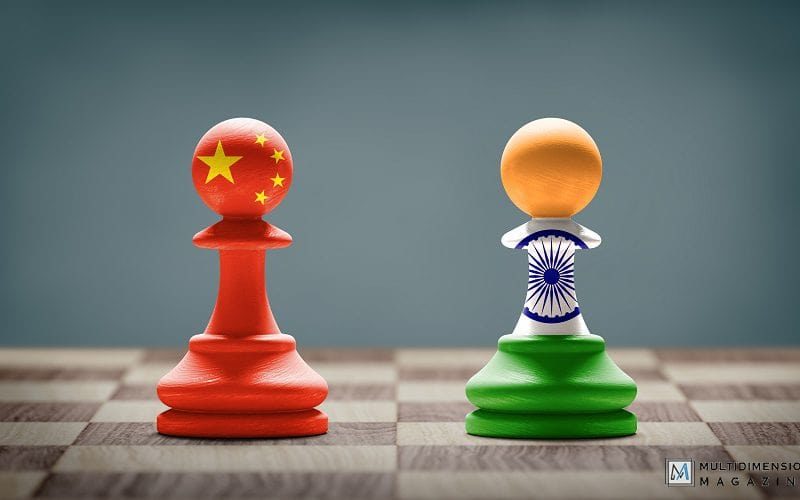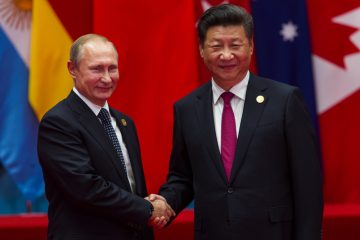Written by : Pratip Chattopadhyay
Photo : shutterstock.com
Snippet:
In the midst of Covid pandemic the latest tension in western sector of Indo-China border around Ladakh region has exposed blatantly the pandemic that has set in Indian (non) -foreign policy towards China in post-Cold War period due to India’s over-dependence on and over-self-presence before United States of America to use India as US ploy against China in Asia. So autonomy of India’s foreign policy towards China has been jeopardised. Off late Dokhlam stand-off in 2017 and Ladakh border skirmish are seen as attempts to recover whatever is left of ‘autonomy’ in India’s policy towards China. In this context the article reflects critically on India’s policy orientation in 2020 towards China based on historical, theoretical and practical experiences.
Introduction:
India’s foreign policy since independence has been personality-based where Prime Minister rather than government in power acts as adjective to foreign policy. From Nehru’s foreign policy to that of Modi’s, China has influenced the texture of Indian foreign policy orientation much. Starting from a sweet-tooth ‘hindi-chini bhai bhai’ of 1950s to a mature-jawed nationalistic ‘India first’ policy of 2020’s India has never been able to make China act to her terms and desires in the subcontinent. As a result India’s latest claim of ‘self-reliance’/atmnanirbhar posture domestically doesn’t match with her other-self-dependence/paranirbhar posture internationally to tackle China. India’s policy towards China historically is a part of her overall policy towards South Asian region. Historically the fate of India’s foreign policy towards both South Asia as a region and China in particular has been a tale of friendless-ness and wilderness principally due to its lack of attention to a collective regional prosperity model. India eyed global recognition and status much to the neglect of her neighbouring countries and created a vacuum which gradually China covered strategically. India’s developmental path never reached an economic superway to embark on a pan-Asian developmental initiative like the BRI initiative of China. Every event and issues in South Asia, particularly related to India, needs to be viewed in this perspective.
Sino-Indian border dispute 2020:
In 2019, the Indian government’s decision to dismantle the Jammu and Kashmir state has effected Delhi’s relations with Beijing. The Indian government did not realize the consequences of its abrogation of Article 370 that had given the special status to J&K and its bifurcation of Ladakh from J&K. Now Ladakh has become a new contentious frontier between India and China. Although India tried to convince China that changing the Ladakh’s status is an internal matter of India, it would not affect the LAC. But it seems that Beijing was not ready to buy India’s argument. Beijing even brought the issue to the UN Security Council. It is perceived that this act of the Indian government has not only jeopardized China’s claim on Aksai Chin and its control over Shaksgam valley; but it also jeopardized China’s effort to contain its investment in the China-Pakistan Economic Corridor (CPEC), part of China’s most celebrated Belt & Road Initiative (BRI) project. By making these kinds of decisions, the Indian government cannot deny their share of increasing the geopolitical tension in the region (Ahsan, 2020).
The Modi government has ordered a change in strategy to deal with China. The first signs of this shift came as the Indian Army significantly strengthened its presence on ‘strategic heights’ and enhanced deployment of troops and weapons at key points around the Pangong lake. It’s an issue of national security and protecting the territorial integrity of India. The government led by Prime Minister Narendra Modi has given the go-ahead that India needs to signal China that it can throw counters,” a senior leader in the government said. A senior BJP leader said, “The government is under pressure — strategic and political. On one hand, the terms of discussions at the negotiation table with China needed to be changed. And then, national security has been the mainstay for the BJP. The domestic constituency can’t be left unaddressed.” (Srivastava, 2020).
As India confronts a “new normal” on the LAC, India cannot rely on old strategic paradigms. Indian policymakers are making it clear that everything is on the table if China doesn’t mend its ways. While they need to make it clear to Beijing that they indeed have the resolve to escalate, they will have to factor in not only the first, but also the fourth and fifth rung on the 50000escalation ladder. It’s a delicate balancing act but a necessary one if India is to move beyond the sterile debate of it having no real military options vis-à-vis China on the one hand and seemingly a range of options which are never really specified (Pant and Bommakanti, 2020).
What is most interesting to note is non-response from neighbouring countries as well as from United States of America and other QUAD members like Japan and Australia on the ongoing Indo-China border dispute. This non-response is an indication that despite India’s best diplomatic effort on India really has no friend to side by her in times of need. Therefore India’s relentless effort to court USA and USA-backed world order and USA-penned vision of South Asia has not delivered its desired result. India remained alone to battle odds against Pakistan or against China by introducing innovative tactics (surgical strikes against Pakistan or military cold war against China). Therefore the primary motive of non-alignment has actually transformed into international isolation for Indian foreign policy in the new millennium. It is because of structural myopia inherent in Indian foreign policy making where internal economic development induced economic partnership was given more credence over and above geographically, geopolitically and strategic partnership which is the main raison-d-être behind foreign policy.
Conclusion:
Theoretically Indian foreign policy has always been realist in orientation which looked for strategic economic fruitful partnerships with countries beyond neighbourhood. As a result the ‘thorns’ in bilateral relations in neighbourhood remained mostly unaddressed. On China the much sought after Henderson-Bhagat report has not been published publically to cull out the main eventalisation of 1962 war, which has remained a demand from the Communist parties of India for long. China followed a unique foreign policy of realist constructivism where it used military might to create an identity of pole of power and prosperity in international and regional politics. India on the other hand must proceed for a liberal constructivist foreign policy to use anti-imperialist, world peace and collective security as the guiding principles to create an identity of ethical political and economic power in international and regional politics. To begin in that direction the left over imagery of Indian foreign policy, i.e. of nonaligned country needs to be followed by not getting involved in US-dictated military extravaganza like QUAD directed particularly against China. Today India is literally frustrated as reflected in her Minister of External Affairs, S. Jaishankar’s remark about inability of India to force Chinese troops away from the western sector Ladak border before winter sets in. Indian soft power resistance tactics like banning Chinese goods and firms’ operationalisation in Indian domestic market and hard power tactics of escalating forces around the western sector border have had hardly any impact. Actually India has not in stil confidence in China or for that matter among her small neighbouring countries that it will not let her be used by United States of America against them implicitly or explicitly. The present limbo in Indo-China is basically a product of hollowness of Indian non-foreign policy which in its desire to get global power status (entry as permanent member of UNSC) entered in the cobweb of global military high table to raise index of her domestic economic prosperity only to be considered as a middle power looking for support of P-5 countries and gradually losing confidence of smaller neighbouring countries in South Asia who looked to India as a power less interested in regional business. China entered in the empty space of South Asia and slowly increased networking inroads with South Asian countries leaving India as a ‘second choice’ for them. Today India has suddenly awakened herself to the reality of establishing regional power status and started looking at China eye-to-eye in all events. But it’s too late to affect China or matrix of regional influence for Indian non-foreign policy. So the task at hand is to build upon the left-over of foreign policy in India with elements rooted in Indian history, civilisation, freedom struggle and nation-building process – simply to gain dignity, self-respect, autonomy and resoluteness. This structural transformation from non-foreign policy to foreign policy in Indian policy circle will create more spaces of mutualisation of interests both at regional and global level and also correct the course of relationship with China. But is the domestic power-centre in India ready to initiate such change? Good fortune befall them in post-Covid era!
References:
- Ahsan, Seraj(2020): India-China Relations: Between Confrontation and Cooperation,
- Srivastava, Rahul(2020): India-China standoff: How and why govt changed strategy on dealing with Beijing,
- Pant, Harsh V and Bommakanti, Kartick(2020): The New Normal Along the LAC,
(The views expressed in this article are the author’s own and do not necessarily reflect Multidimension’s editorial stance.)
About the author :
Pratip Chattopadhyay
Assistant Professor, Dept. of Political Science, University of Kalyani, West Bengal, India




